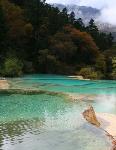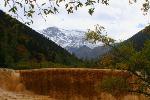- Getting around Lijiang. Dont stay in the Old Towns more than 2 days, there is nothing to do. KRISS Oct 9, 2013 05:46
- 2013 Beijing Temple Fair BENNYLAU Feb 26, 2013 03:29
- Malaysian traveling from KUL - LAX vis Shanghai PVG ZATI_DY Jan 3, 2013 20:15
Huanglong: The Hidden Jewel of Sichuan
- Views: 5643
- |Vote: 0 0
- |Add to Favorites
- |Recommend to Friends
A Holy Site
Laying almost directly in between the popular tourist destinations of Jiuzhaigou and Songpan, Huanglong National Park is a site that is often over looked by tourists. However, one will be hard pressed to find a natural site that matches Huanglong’s unique beauty. Here, the tourist blurbs aren’t lying when they proclaim Jiuzhaigou and Huanglong the world’s ‘Fairylands on Earth.’
Like Jiuzhaigou, Huanglong is the site of a rich history for the Tibetan and Qiang ethnic groups. With its otherworldly topography, Huanglong has served as an important religious site for the Tibetan people for centuries. Also calling the park home are the endangered giant panda and the golden snub-nosed monkey, although it’d be highly unlikely to spot one of these creatures in the wild.
Because of the valley’s relative isolated location and its importance in Tibetan religion, it has been spared the development and heavy tourism that have reached Jiuzhaigou. However, as the word spread about Huanglong’s natural beauty and the flux of tourism began to increase, in 1983 the park dedicated a World Heritage Site by the United Nations.
A Natural Wonder
Like it’s famous neighbor, Huanglong was formed by millions of years of glacial activity. It’s main valley snakes it’s way through the earth, creating the vision that has been likened to the tail of a dragon. The shimmering scales composing this natural wonder are in fact calcium carbonate and limestone deposits, which feed into a number of hot springs and waterfalls. However, if you arrive with your swimsuit you’ll be greatly disappointed: there’s nowhere to go for a soak. (Which probably is a good thing, as one can only imagine what a zoo that would make of the place!)
Aside from the park’s legendary multicolored pools, Huanglong can also boast a number of awesome waterfalls that should not be missed (Liantai waterfall is a must see.) Also en route are a number of Tibetan temples (you’re likely to share the trail with pilgrims), and, of course, the amazing Yuchuifen Shan (Yuchuifen Mountain.) All of the pools are concentrated along the main route, which peaks at 5,500 meters (and yes, the oxygen does get noticeably thinner up there!) There are too many pools to list, and each is unique in color and depth, ranging from an aqua blue to green, white and a number of shades of yellow. If you hike the trail both ways, or one-way at the least, there’s no way to miss any of the major pools; they’re all along the main path.
To Go Or Not To Go...
One of the only drawbacks of going to Huanglong is also one of its virtues: it’s relative inaccessibility. Now tell this to a Chinese tourist and they’re likely to disagree with you – vehemently. There is definitely not a shortage of Chinese tourists at the park. On the other hand, for a westerner it’s a bit of an ordeal to get there, but even more of an ordeal to leave.
Coming from Jiuzhaigou it was pretty straightforward to get to the park. A daily bus departs the main bus station at 7 am each morning. Leaving from Songpan is not so easy though, as I’ve heard from fellow travelers. There are no buses that go from Songpan to Huanglong, so it’s necessary to hire a taxi for the trip (about two hours one way.) If you’re able to share a taxi this isn’t such a bad option though.
The journey from Jiuzhaigou to Huanglong takes about two and a half to three hours, depending on the weather, and passes through beautiful scenery along the way. One of the first things you’re likely to notice when you arrive in the Huanglong ‘town’ is that there is a serious shortage of accommodation. In our case, we’d planned to arrive that morning, check out the town for the remainder of the day, then wake up the following morning to explore the park. We soon came to realize this plan was only feasible if one has about 600 Yuan to spend on a hotel room – at the least! There are only a few choices of hotels in the vicinity and these cater to the predominantly upper class tour group category. However the rooms did look very nice if you’re in the mood for a splurge! I’ve also heard reports of some basic lodging within the park (which would be a great experience), but I didn’t see any cabins myself.
If one wishes to visit the park in a day and thus bypass the expensive lodging in Huanglong town, then it seems the way to go (and this is what we did) is to get an early start, see the whole park in half a day (which isn’t hard to do) and then share a taxi to Songpan. The park itself isn’t difficult to traverse in a few hours since there is only one path to hike either way. If you happen to get a late start there is also a cable car that can take you half way up the mountain, although walking at least one direction is recommended if you really want to experience the beauty of the valley. If you’re feeling a little weary about the elevation gain, don’t despair: once you reach about half way up the mountain there are oxygen stations galore! (This also becomes quite a source of entertainment, as some hikers are a wee bit overly dramatic to say the least!)
Once you’ve seen the park and are ready to hit the road to Songpan (western food and cheap accommodation awaits!), the next step is to arrange for a decently priced taxi to make the journey. If your situation is anything like ours was, you’ll be exiting the park in the early evening, exhausted from a day of buses and hiking and will be ready to check into your hotel room. (Luckily, though, you’ll have been spared the nightmare of lugging your backpack around the park all day, as there is an awesome visitors’ center at the park’s entrance that will hold your luggage for free!)
In leaving Huanglong, the ideal situation would be to arrange for a shared taxi with other Songpan bound tourists. If this isn’t possible though, you’ll have to cover the fare on your own, and with it being a two hour ride you’re not likely to pay anything less then 230 Yuan. Believe me, we don’t have sucker written on our faces, and we bargained like madmen before we finally succumbed to paying the fee, but the truth is 1) no one is very eager to drive that far at the end of the day, and 2) all of the drivers know you have no other choice but to take one of their taxis to Songpan (or be stranded); thus bargaining isn’t much of an option.
Another thing to watch out for is the old ‘switch-a-roo’ that the cabbies might try to pull on you. We came to realize that most, or all, of the cabbies live outside of the park's entrance/exit live in the general vicinity of Huanglong and don’t want to drive as far as Songpan. Especially that late in the evening it simply doesn’t make economical sense for them to be driving all the way there. Therefore, they’ll negotiate a fare with you, drive you to the top of the hill (in heavy fog this can be an intense ride to say the least!), pull over to the side of the road and hand you off to a fellow driver who will then take you the final leg of the journey. If you’re tired and mildly depressed about the money you’re about to fork over for the ride, then this seemingly scamy maneuver might be enough to put you over the edge. After enduring a white knuckled ride through the fog, on the wrong side of the road, we thought we thought we were about to be deserted in the middle of nowhere or ridiculously bribed just to finish the rest of the trip, but alas the divers had it all worked out, so it was best just to relax and enjoy the ride.
The Journey is Half the Fun
While not entirely ‘off the beaten path’, Huanglong does take more effort to reach than the average tourist destination, especially if you’re a foreign tourist with limited Chinese capabilities! However, if you decide to visit the park you will not be disappointed. Having visited a number of mountains and natural sites in China, I would honestly have to say this is my favorite site yet. While it wouldn’t be fair to compare it to its ever-popular neighbor and visually unsurpassed neighbor, Huanglong holds it’s own in the contest of pristine natural beauty and simplicity. While attracting it’s fair share of visitors (we were almost pushed off the planks and into the pools on a number of occasions by the massive crowds!), it is able to remain a sort of hidden gem in this heavily touristed region of Northern Sichuan.
On a side note, another reason to visit Huanglong is it’s wonderful museum and visitors’ center (where you can stash your bags!) The designers of the museum have done a great job putting together a variety of informative and attractive displays on the histories of the various ethnic groups that inhabit the park. It’s a must see for anyone interested in the Qiang and Tibetan minorities.
General Information
Getting there:
* There are a number of ways to reach Huanglong, however it’s the most straightforward from Jiuzhaigou. The bus departs daily from the station at 7am and lasts three hours.
* From Songpan: Shared taxi
* From Chengdu it’s possible to join a tour that visits all of the major sites in the area, including Songpan and Jiuzhaigou.
Admission and Fees:
* General admission: 200 Yuan
* Student admission: 160 Yuan (If you can show anything that resembles a student ID you shouldn’t have any problems getting the discount.)
* Cable car: 40 Yuan per direction
Park Hours: 7am to 6pm daily







 Copyright © 1998-2025 All rights reserved.
Copyright © 1998-2025 All rights reserved.